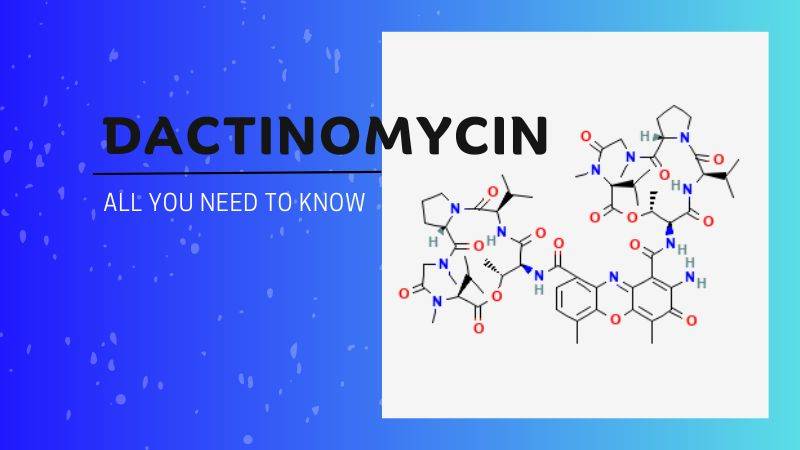Dactinomycin, also known as actinomycin D, is an anticancer (antineoplastic or cytotoxic) chemotherapy drug. It’s classified as an antitumor antibiotic.
It is a potent drug that is primarily used in cancer treatment or in research due to its unique mechanism of action and significant side effects.
Let’s dive into the details to understand why:
Mechanism of Action
Actinomycin D functions by intercalating between the guanine and cytosine base pairs in the DNA double helix.
This action prevents the normal function of various enzymes involved in DNA replication and RNA transcription.
As a result, it effectively inhibits cell division and protein synthesis. While this mechanism is effective in killing fast-dividing cancer cells, it also affects healthy, rapidly dividing cells, such as those in the gastrointestinal tract or hair follicles, leading to various side effects.
How does Dactinomycin Work?
Dactinomycin binds to DNA in the cell and interferes with the cell’s ability to synthesize RNA, which is the molecule that carries instructions from DNA for protein synthesis.
This inhibition of RNA synthesis disrupts the process of protein production, a critical step for cell survival and replication.
Dactinomycin cannot differentiate between cancer cells and healthy cells. Therefore, it will also bind to the DNA in normal cells, disrupting their functions.
This effect on normal cells can lead to the side effects seen with this drug. It’s one reason why the use of dactinomycin is generally limited to certain types of cancer and research applications.
Like other chemotherapy agents, dactinomycin is most effective against rapidly dividing cells, such as cancer cells.
However, other cells in the body, like those in the gut, bone marrow, and hair follicles, also divide rapidly and can be affected by the drug. This can lead to side effects like nausea, hair loss, and low blood counts.
How do You Have Dactinomycin?
Dactinomycin is administered intravenously, which means it is delivered directly into your bloodstream through a drip.
For the course of the treatment, you may receive the medication through a long plastic tube inserted into a large vein in your chest. This tube, which remains in place throughout the treatment duration, could be any of the following:
- A central line
- A PICC line
- A portacath
If you don’t have a central line in place, the treatment may instead be administered through a short, thin tube, known as a cannula, which is inserted into a vein in your arm. In this case, a new cannula is used for each treatment session.
What are the side effects of Dactinomycin?
Like most chemotherapy drugs, dactinomycin can cause side effects due to its impact on both cancerous and healthy cells, especially those that divide rapidly.
Common side effects of dactinomycin can include:
Nausea and Vomiting: These are common but can usually be controlled with anti-nausea drugs.
Low Blood Cell Counts: This includes neutropenia (low white blood cells), thrombocytopenia (low platelet count), and anemia (low red blood cells). Low blood cell counts can increase the risk of infection, cause fatigue, and result in bleeding or bruising after minor cuts or injuries.
Hair Loss: Hair loss is common but typically temporary.
Mouth Sores: Dactinomycin can cause sores in the mouth or throat.
Diarrhea: This can occur and can sometimes be severe.
Skin Changes: Some people might experience redness, rashes, or sensitivity to the sun.
Less common side effects can include liver changes, allergic reactions, changes in menstrual periods, and in rare cases, a second malignancy.
What is the reason to use Dactinomycin in Cancer Treatment and Research only?
Specificity for Rapidly Dividing Cells: Cancer cells divide rapidly and uncontrollably, which is one of the main characteristics that differentiate them from normal cells. Dactinomycin works by inhibiting RNA synthesis, which is a crucial step in cell division. This makes it particularly effective against cancer cells.
Broad-spectrum Anticancer Activity: Dactinomycin is effective against a wide range of cancers, including Wilms’ tumor, Ewing’s sarcoma, rhabdomyosarcoma, and certain types of testicular cancer. It’s also used in combination with other drugs to treat a variety of other cancers.
Research Value: In research, dactinomycin is used to study the mechanisms of RNA synthesis and cell division. It’s also used to investigate new treatment strategies and combinations of therapies.
However, it’s important to note that dactinomycin also affects healthy cells that divide rapidly, such as cells in the gut, bone marrow, and hair follicles. This can lead to significant side effects like nausea, hair loss, and low blood counts. Additionally, dactinomycin can cause harm to a developing fetus and is usually avoided in pregnant women.
Given these side effects and risks, the use of dactinomycin is typically restricted to treating specific cancers where the benefits outweigh the potential harms.
Its use in research is similarly confined to controlled laboratory settings. It is not used for common, less severe conditions or diseases due to its potent and potentially harmful effects.






